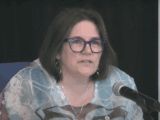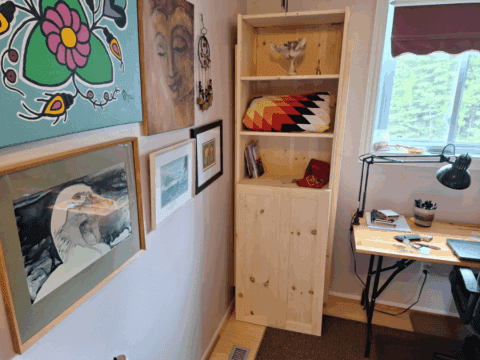I fell in love with Slocan Lake in southern B.C. the same way I fell in love as a teenager: head over heels, infatuated, besotted, enamoured. I couldn’t stop sneaking peeks: green mountain valleys cupping plunging creeks, glacier-melt waterfalls, rocks tumbled by water and cracked by ice, water that was clear, clean and slap-in-the-face cold. Heaven help me, in late middle age I started skinny-dipping! I just couldn’t get enough of this lake. At odd moments, I’d find myself belting out, “Then sings my soul, my Saviour God, to Thee. / How great Thou art! How great Thou art!”
Like any love affair, there was a fair amount of projection. When I accidently stumbled onto Slocan Lake nine years ago, I immediately pictured myself living there for the rest of my life. I imagined a log house with a wide green lawn descending to a sandy beach, a dock, a fishing boat, a kayak or two. I saw our kids and grandkids eating pancakes on a misty summer morning. I heard silence, loons and laughter, and I imagined ease.
Nice pictures, and a lot like what used to happen when I was 16 and lovesick. I used to fall for anyone I thought had potential, “potential” being code for “I don’t want you the way you are; I want you to become who I think you should be.”
But as I learned when I grew up, there’s a bit more to real love than shaping someone to meet your desires. Love starts getting real when you lose your fantasies about changing the other. With Slocan Lake, that came as soon as my husband and I started looking at property. “Can’t cut these trees here to get a better view,” the builder said, “because that’s protected easement for the walking trail.” “Can’t put a dock in,” the neighbour said, “because it’s too close to the creek mouth.” “Can’t put a green lawn down to the water,” the guy at the store said, “because that’s riparian area.” “Can’t dump sand on that rocky beach,” the plant lady said, “because those rocks are spawning ground for the kokanee.”
After I got over my disappointment — why couldn’t I have my dream cottage? — I started to see the real lake. This lovely body of water wasn’t a large swimming pool around which I could play out my childhood fantasies, but a living ecosystem with its own integrity. I began to understand that much of what drew me to the location — the clarity, the wildness, the silence — was under pressure from people like me who didn’t understand the first thing about lakes and how they function.
Again, I was reminded of those teen years, and the guy who swore he was in love with me after our first date. I later discovered that he said that to all the girls: it was how he convinced them to make out. This memory helped me understand my own grasping, and that some of my neighbours who were damaging the lake in their grab for pleasure didn’t really know what love meant. True love means you learn who the other truly is. Since I wanted my relationship with this lake to be true love for life, I got active in the local lake stewardship society and started learning.
I learned that if more than 30 percent of the shoreline of a lake is developed, the lake’s ecology is permanently changed. I found out that the foreshore serves both as nursery and feeding ground for fish — those pesky “weeds” that I wanted to pull and the rocks I wanted to cover with sand were both essential. I discovered that green lawns don’t stabilize the shore but instead funnel fertilizer and pesticides right into the water. I realized that some of those lovely old cottages I coveted were leaking sewage into the groundwater. I found out that many lakes — including Lake Winnipeg, the second-largest watershed in the country — are choking to death on sewage, detergent and fertilizers. I learned that invasive species not only drive out native plants and animals; they also impact fish, power generation, water intake and recreation.
I discovered that most lake-management plans aren’t written until after the damage is done. I learned that restoration is much, much more expensive than prevention. And finally, I uncovered the dirty secret about the enforcement of laws protecting water and fish: it rarely happens.
When I was a teen, I fell in love with a boy of a different racial and ethnic background. I remember the despair I felt as the wide differences between us became apparent. In the end, the relationship collapsed under the weight of our mutual ignorance and the intractable prejudice of our communities.
I reached a similar point of despair in my relationship with Slocan Lake. I felt overwhelmed by the work, embarrassed by my ignorance, weighted down by the bureaucratic hoop-jumping required to protect it. My despair manifested itself as an inability to swim in or even walk beside the water. I’d go to the mouth of the creek and — courtesy of someone’s dirty waders — it would be clogged with didymo, an invasive algae. I’d walk the trail north to my favourite beach and discover part of the foreshore cemented over for someone’s patio. I’d kayak south and find heavy machinery “grooming” the beach. My heart wouldn’t stop breaking. All I could see were problems. What rang in my mind those days was Hamlet’s cry: “The time is out of joint. O curséd spite / That ever I was born to set it right!”
But ultimately, my model for love relationships is my parents’ marriage, and I come from sturdy and committed stock. My mother and father loved each other through great challenges: eight children, my dad’s lifelong struggle with depression, leaving family and friends to move across the continent, the death of a child. I learned from them to hang on. I learned from them to put one foot in front of the other. And from them, I learned to pray the psalms and canticles, including this passage from Habakkuk: “Though the fig tree blossom not, nor fruit be on the vines, though the yield of the olive fail and the terraces produce no nourishment, though the flocks disappear from the fold and there be no herd in the stalls, yet I will rejoice in the Lord and exult in my saving God.”
Alanna Mitchell — author of the international bestseller Sea Sick: The Global Ocean in Crisis — spoke in June at the annual meeting of the United Church’s British Columbia Conference. She emphasized that the narrative is not yet complete for our world. We have the power and the responsibility, she said, to clean up the mess we are making. As we sat in worship together, I remembered that one of the things our faith teaches us is that, all evidence to the contrary, we are to trust in our saving God and do the work we have been given in this lifetime. At least part of my work, it seems, is to remain committed to loving and protecting this lake and respectfully enjoying what God has given here. I don’t have to be a fish biologist to contribute to the care of Creation.
So if you love a lake, come on in. The water’s fine. And let me share with you the language of love that expresses my feelings these days. These are some of the terms of endearment that now thrill my heart: Lake stewardship society. Lake management plan. Community meeting. Habitat restoration. Letter of objection to development variance request. Spawning channel. Aquatic vegetation. And some days, heaven help me, “stop-work order” and “skinny-dipping.”
***
This story first appeared in The United Church Observer’s September 2012 issue with the title “Loving our lakes to death.”














